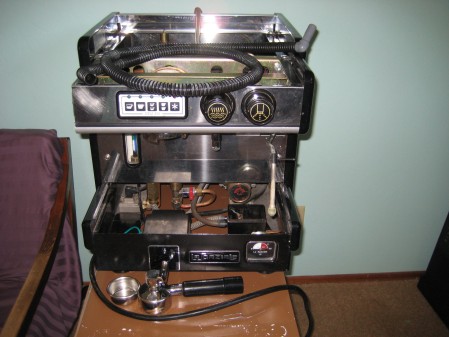As part of my general troubleshooting I carefully examined the machine parts diagrams provided by La Spaziale and compared them with what I have. Looking at the diagram of the boiler, I noticed that instead of this part

water level probe
very common on commercial espresso machines (with a single wire coming off of it), I instead had two ragged-looking wires going straight into an open hole in the top of the boiler. Underneath was this narrow, blackened metal stick with a little barrel on the end:

floating water level sensor (shorter piece next to the heating element)
The diagram for my particular model of La Spaziale clearly showed BOTH parts as part of the boiler set-up. These parts are responsible for telling the machine when to turn on the pump and automatically refill the boiler to the correct capacity. Without these parts, the only way to keep the boiler water level accurate was to manually refill the boiler, a difficult and awkward task that would be necessary after nearly every shot poured. Naturally, I thought the first part, the probe, fitted into the part shown above, then screwed into the top of the boiler. The only question was, then, why did I have two wires instead of one?
Now, the replacement part shown above was listed at $197.00 and the part I thought was missing costs $28.00. I was very glad that I did not need the more expensive floating sensor, only the $28 (plus S&H and taxes) probe. When it arrived, however, I could not seem to get the two parts to work together. At that point I should have immediately called the parts store and asked. When I did finally call to ask whether I had indeed received the correct part, it was already too late. I had, very foolishly it turns out, destroyed the $200 part by ripping out the wires together with the silicon that keeps them in place.
When I spoke with the friendly and helpful parts dealer, Marc, who I gathered is the proprietor of Coffee San Marco, I learned that my machine uses one OR the other type of water level sensor, not both. That wouldn’t be so bad if I could just swap out the expensive part I destroyed (after spending hours soaking and cleaning it, too) for the more common and much less expensive probe. Marc told me I could TRY to do this, but it probably would require some reprogramming of the machine (and messing with the wires, something I have very little experience with). I found an internet forum that explained how to reprogram the machine to take the other kind of probe. However, after speaking with an experienced commercial espresso repairman and also asking the individual reputed to be the most knowledgeable veteran of La Spaziale machines in North America, Silvano (of Walnut Creek, CA), I was told that my “newer” year model of this machine was NOT programmed to allow reprogramming from one type of probe to the other and I could ONLY use the $200 type of water level indicator. I was left with the feeling that it MIGHT work, but that I’d be taking a chance and I might even mess with the computer, causing more costly damage. Even to test it out, I would have to strip the wires so I could attach one to the common manual probe and the other to a ground. Then I would have to hold down buttons in a particular manner while turning on and off the machine to reprogram it to accept this type of probe. If that didn’t work, I would have to re-fit the two wires so that I could attach them to the pricey floating sensor. Of course, I also asked everyone whether or not I could just replace the wires and silicon on the my original floating sensor. The answer was a definite NO from all three experienced men. No, the wires must be placed very PRECISELY inside the tube. There is no way to do this at home.
This has been a painful mistake. It may seem silly, but beyond the usual frustration with fuck-ups like this, I let it it get under my skin. This is not a good time for me to be spending nearly $200 (plus other parts) on a hobby. I thought about just leaving it for now, but I’m obviously so involved in this overhaul project that it would be equally frustrating to let the machine sit while I wait for a time of greater financial stability to fork out the dough. I suppose everyone who messes around with stuff, whether it be fixing up cars, bikes, audio equipment, or construction, goes through these kinds of costly trials. I doubt it is very common that the cost is so high, however (except perhaps with car parts or fancy road bike parts).

$197 plus S&H and taxes for this part alone. And I destroyed it!











